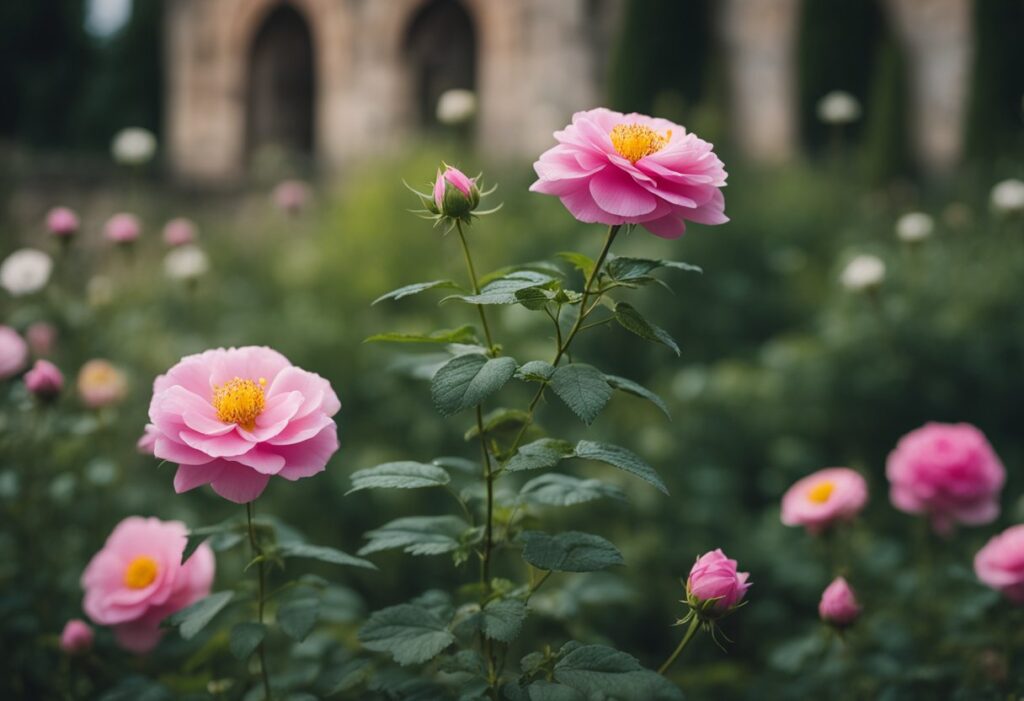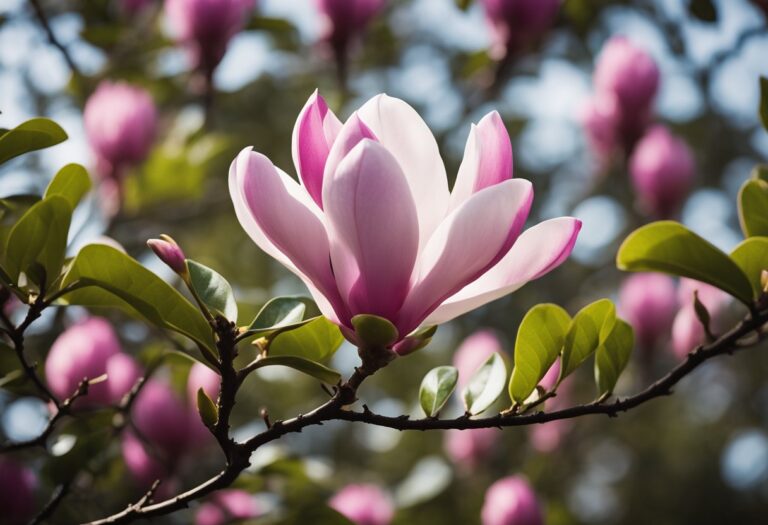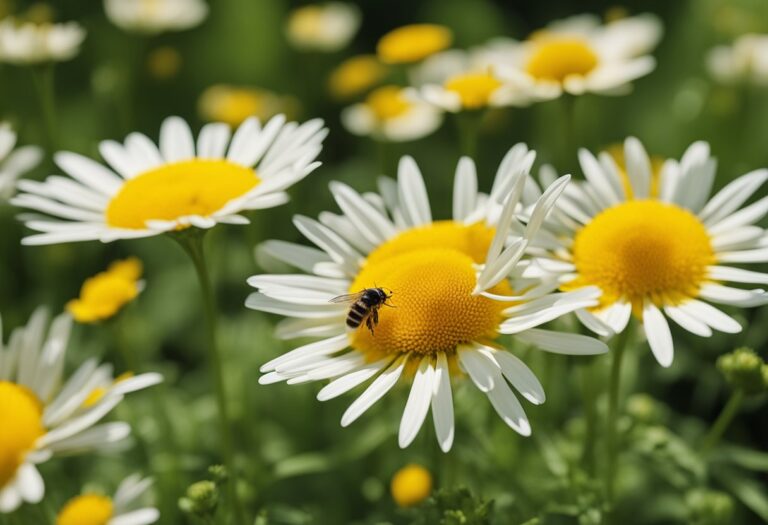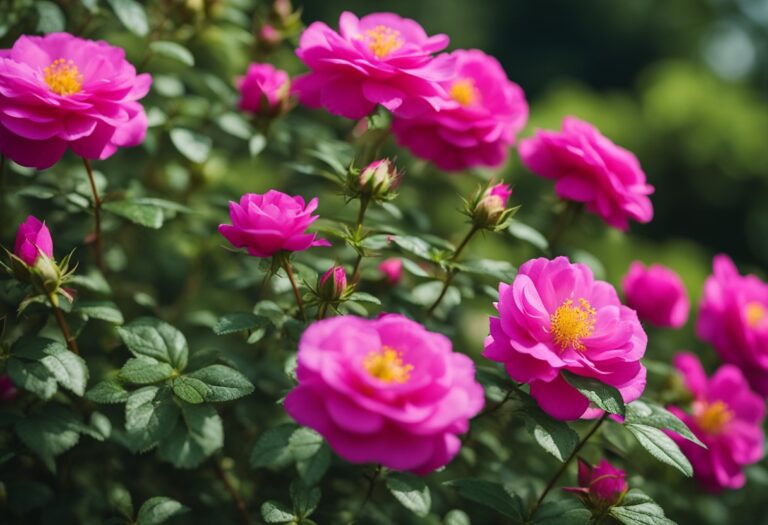Overview of Rosa Gallica Officinalis
Rosa gallica officinalis, also known as the Apothecary’s Rose or Old Red Damask, is a historic rose that is both beautiful and robust. You’ll recognize it by its semi-double, deep reddish-pink flowers which exude a rich fragrance.
This rose is known for its hardiness and ease of care, making it a reliable choice for your garden.
Characteristics:
- Growth: It develops into a compact shrub, typically forming large patches.
- Flowers: Expect clusters of one to four flowers with each featuring a classic, deeply colored and scented blossom.
- Leaves: Look for bluish-green leaflets that are pinnately compound, contributing to the plant’s attractive foliage.
Cultivation:
- Light: Plant it where it will receive full sun to partial shade.
- Soil: It thrives best in well-drained soils.
- Skill Level: It is very approachable for beginners due to its resilience.
As the parent to many floribunda and hybrid tea roses, Rosa gallica officinalis has a prestigious lineage. By including this species in your garden, you’re not only growing a beautiful rose but also a piece of history.
This rose is known for being disease-resistant and quite low-maintenance, requiring minimal interventions from you. Whether you’re an experienced gardener or just starting out, Rosa gallica officinalis can be an outstanding addition to your garden’s floral display.
Historical Significance

Rosa Gallica Officinalis, also known as the Apothecary’s Rose, has a storied past deeply rooted in both medicinal practice and cultural symbolism. Your understanding of this rose’s historical impact is enriched by learning about its roles in healing and how it shaped societal emblems.
Medicinal Uses
Historically, you might have encountered Rosa Gallica Officinalis in medicinal contexts, being cultivated by the Greeks and Romans. Its key significance lies in its:
- Therapeutic Properties: Recognized for its use in traditional remedies, especially in treating an array of ailments.
- Apothecary Staple: The rose was a common ingredient in tinctures and ointments, signifying its importance in early pharmacopoeia.
Cultural Impact
Rosa Gallica Officinalis left an indelible mark on culture:
- Heraldry: The rose became a potent symbol during the Wars of the Roses; Henry VII created the Tudor Rose, combining the white rose of York and the red rosa gallica, symbolizing unity.
- Perfumery and Ceremonies: The pleasing scent elevated its status in ceremonies and perfumery, spreading its prestige beyond the confines of medicine.
Cultivation Details

Rosa gallica var. officinalis, known for its historical significance and fragrant blooms, thrives with careful attention to its growth needs and propagation methods.
Growth Requirements
Sunlight: Your Rosa gallica var. officinalis prefers full sun to flourish. Soil: Plant it in well-drained soil, ensuring it is not where roses previously grew to avoid disease buildup. Watering: Moderate watering is required, as this plant is somewhat drought tolerant but should not be left overly dry. Fertilizing: A balanced fertilizer will support healthy growth, especially during the growing season. Pruning: Early spring pruning helps maintain its shape and encourages vigorous flowering.
Propagation Methods
Cuttings: You can propagate by taking semi-hardwood cuttings in summer. Layering: Another effective method is layering, where you bend a low-growing stem to the ground, notch it, and cover the notch with soil to encourage rooting. Seed: Growing from seed is possible but less common due to variability and longer establishment time.
Botanical Characteristics

Rosa gallica var. officinalis, commonly known as the Old Red Damask Rose, is a deciduous shrub that showcases a harmonious blend of form and function in your garden. Your rose will typically grow to a height of 3-5 feet (about 90-150 cm) tall and will spread similarly, creating a perfect balance in terms of space.
The leaves of your plant are pinnately-compound, consisting of three to seven bluish-green leaflets that contribute to its classical beauty. Throughout the blooming period, which occurs in late spring to early summer and lasts approximately 3-4 weeks, you will observe a captivating display of semi-double, rosy-crimson blooms.
Each flower reaches up to 8 cm across and exhibits prominent yellow anthers which add to the visual appeal.
Here’s a brief breakdown of the main botanical characteristics:
- Height & Spread: 3-5 ft. tall and wide (90-150 cm)
- Flower Size: Semi-double blooms up to 8 cm across
- Blooming Time: Late spring to early summer
- Leaves: Bluish-green, with 3-7 leaflets per compound leaf
The growth habit of your Rosa gallica var. officinalis is compact and bushy, presenting a rounded form that brings structure and definition to any planting area. Perfect for borders and fragrant low hedges, it not only captures attention with its aesthetics but also contributes to a sensory garden experience with its rich fragrance.
After the flowering season, your shrub will produce small orange-red oval hips, which are not only aesthetically pleasing but can also provide interest in the fall and winter months. This rose variety is well-adapted to different garden styles, making it an enduring favorite for both its history and its horticultural qualities.
Conservation and Preservation

You should be aware that the Rosa gallica var. officinalis, also known as the Apothecary’s Rose, is not just historically significant but also ecologically valuable. Its conservation is vital for maintaining biodiversity and preserving an important genetic lineage in the realm of roses.
Habitat Threats
- Urban expansion and infrastructure development pose significant threats to the natural populations of Rosa gallica. As cities grow and transportation networks expand, the natural habitats of this species are often destroyed or fragmented.
Conservation Efforts
- Botanical Conservatories: Organizations, such as the botanical conservatory of Gap in the Hautes Alpes, play a crucial role in conservation by maintaining living collections for future generations.
- Protective Legislation: In some regions, Rosa gallica may be subject to protective laws that prohibit or regulate the alteration of its natural habitat.
- Cultivation: By cultivating Rosa gallica var. officinalis in gardens and parks, you can contribute to preserving its genetic diversity. This also serves educational purposes, providing insights into historical horticulture and medicine.
Actions You Can Take
- Support Conservation Projects: Donate or volunteer with organizations focused on plant conservation.
- Responsible Cultivation: If you grow Rosa gallica, ensure that you source plants from reputable nurseries that do not contribute to the depletion of wild populations.
- Educate Others: Raise awareness about the importance of conserving Rosa gallica and other heritage plants.
Frequently Asked Questions

This section addresses common inquiries about the care, characteristics, health benefits, consumption safety, maintenance practices, and historical significance of Rosa gallica officinalis, also known as the Apothecary Rose.
How can one care for a Gallica rose to ensure optimal growth?
To promote healthy growth of your Gallica rose, provide it with a sunny location and well-drained soil. Fertilize the plant in early spring with a balanced rose fertilizer and ensure regular watering, especially during dry spells.
What are the distinguishing characteristics of the Apothecary Rose?
The Apothecary Rose is known for its semi-double blooms that exhibit a deep reddish-pink color and a rich fragrance. It’s a small shrub that also produces ornamental hips, which are high in vitamin C.
In what ways can Rosa gallica be utilized for health benefits?
Rosa gallica var. officinalis has a history of medicinal use, particularly for its hips, which are rich in vitamin C and often used to make jelly or supplements. Additionally, the petals have been used in traditional remedies and skincare.
Can the petals of the Apothecary Rose be safely consumed?
Yes, the petals of the Apothecary Rose can be consumed safely. They are commonly used in culinary applications such as in syrups, teas, and desserts for flavor and decorative purposes.
What are the common maintenance practices for Rosa gallica officinalis?
Regular pruning after the blooming period helps maintain the plant’s shape and health. Deadheading spent flowers can encourage plants to put energy into hip production rather than seed.
What historical significance does the Old red Damask Rose hold?
The Old Red Damask Rose, or Rosa gallica officinalis, was a symbol of the House of Lancaster during the 15th-century Wars of the Roses in England. It’s also one of the oldest cultivated rose species. The rose is known for its historical use in medicine and perfumery.










